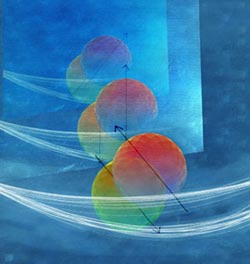Combining quantum information communication and storage

<br>
– This work represents the first step towards creating exotic mechanical quantum states. For example, the transfer makes it possible to create a state in which the resonator simultaneously vibrates and doesn’t vibrate, says professor Mika Sillanpää from Aalto University, who runs the research group.
A qubit is the quantum-mechanical equivalent of the bits we know from computers. A traditional bit can be in a state of 0 or 1, while a qubit can be in both states at the same time. In theory, this inconceivable situation allows for a quantum calculation in which the operations are performed simultaneously for all possible numbers. In the case of a single qubit, this means zero and one, but as the number of qubits increases, the amount of possible numbers and simultaneous calculations grows exponentially.
The quantum state of a qubit is very fragile and easily disturbed between and during the operations. The key to successful quantum calculation is being able to protect the qubit state from disturbances in the environment.
– In this case, the qubit state can be stored as vibration, thus preserving the state for much longer than the qubit itself. The resonator also functions as a mechanical quantum memory, which is something that an ordinary memory can't do, explains Juha Pirkkalainen from Aalto University, who is doing his dissertation on the topic.
The work combines two Nobel Prize winners' achievements in one
The work combined the achievements of both winners of this year’s Nobel Prize for Physics. The qubit state was measured using a superconducting cavity in the same way that Serge Haroche measured atoms, and the qubit state was also linked to mechanical movement as in David Wineland’s experiments. In contrast to these larger-scale measurement arrangements, the experiment at the O.V. Lounasmaa Laboratory was prepared for a tiny silicon microchip. This made it possible to cool the sample to near absolute zero temperatures and then use microwaves.
The group’s results have just been published in Nature, the premier weekly science journal. The study was performed at Aalto University’s O.V. Lounasmaa Laboratory, which is part of the Academy of Finland’s Centre of Excellence in Low Temperature Quantum Phenomena and Devices. Some of the sample used in the measurements was produced at Micronova’s Nanofab cleanroom facilities. The project was financed by the Academy of Finland and the European Research Council ERC.
Link to the Nature article: http://www.nature.com/nature/journal/v494/n7436/full/nature11821.html
Further information:
Professor Mika Sillanpää
Tel. +358 50 344 2794
mika.sillanpaa@aalto.fi
Department of Applied Physics
Aalto Universty School of Science
Juha Pirkkalainen, Doctoral student
Tel. +358 50 344 2394
juha.pirkkalainen@aalto.fi
O.V. Lounasmaa Laboratory
Low Temperature Laboratory
Aalto Universty School of Science
O.V. Lounasmaa Laboratory web pages (ltl.tkk.fi)
Media Contact
More Information:
http://www.aalto.fiAll latest news from the category: Information Technology
Here you can find a summary of innovations in the fields of information and data processing and up-to-date developments on IT equipment and hardware.
This area covers topics such as IT services, IT architectures, IT management and telecommunications.
Newest articles

Machine learning algorithm reveals long-theorized glass phase in crystal
Scientists have found evidence of an elusive, glassy phase of matter that emerges when a crystal’s perfect internal pattern is disrupted. X-ray technology and machine learning converge to shed light…

Mapping plant functional diversity from space
HKU ecologists revolutionize ecosystem monitoring with novel field-satellite integration. An international team of researchers, led by Professor Jin WU from the School of Biological Sciences at The University of Hong…

Inverters with constant full load capability
…enable an increase in the performance of electric drives. Overheating components significantly limit the performance of drivetrains in electric vehicles. Inverters in particular are subject to a high thermal load,…





















